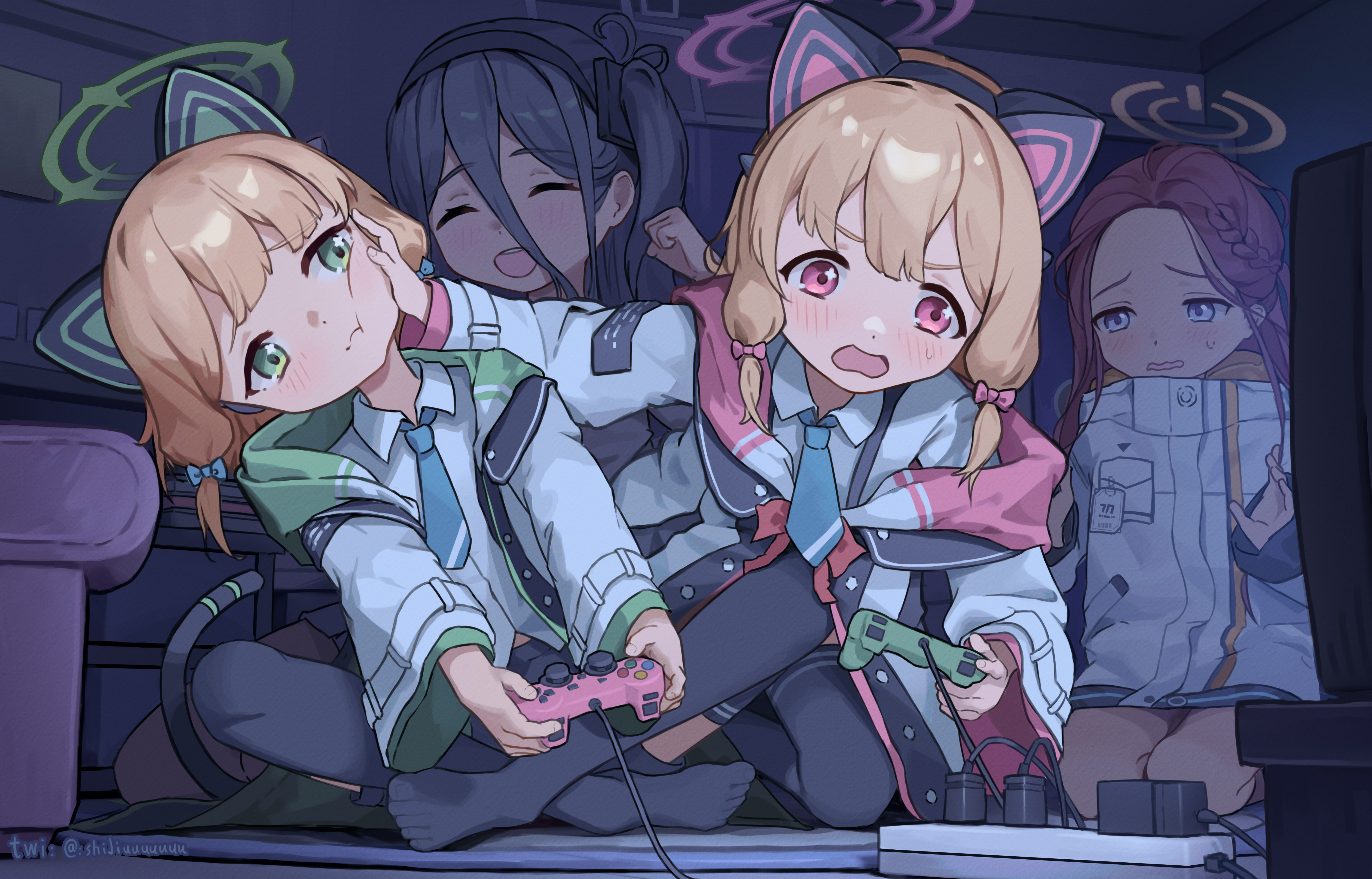This blog’s annual ‘Anime of the Year’ audition for the year of 2014 starts today with my review of No Game, No Life, a potential Xeroxed copy of last year audition candidate Mondaiji-tachi ga Isekai kara Kuru Sou Desu yo? (damn you Japan and their long-ass anime titles). With both anime’s main protagonists having exactly the same grand entrance sequence when they arrived to their own fantasy worlds, comparisons between these two titles is definitely going to be inevitable when you read this review further.
Story:-
Our two main protagonists; two hikkikomori siblings with penchant for video games, none more important than the other, was invited (or forced?) into ‘Disboard’, a mystical fantasy world vastly different from their version of Japan. In Disboard, the game geniuses that they are will be able to challenge other mystical races in non-violent games, so that they can save Disboard’s version of humanity from oblivion.
The first obvious similarity between this anime and the anime with the long name above, is that both of them has multiple main protagonist. This anime has 2, the other one has 3. Personally speaking, I think this anime has better main protagonists than the other one for several reasons. The teamwork between the main protagonists in this anime is much better, while the main protagonists in the other anime series works more independently off each other, with inconsistent results unlike the achievements of this anime protagonists. Synergy in this anime is simply much better than what can be see in Mondaiji-tachi..
It is not that the capabilities of the main protagonists of Mondaiji-tachi is inferior than the abilities of this anime’s main protagonists. For example, Mondaiji-tachi’s main male protagonist’s abilities easily exceeds the combined abilities of this anime’s main protagonists. Not only that his intellect easily matched them, his physical prowess towers over them by a long way. Hypothetically, if he is the one that was invited into Disboard instead of the hikkikomori siblings, he would still be able to win all the games that the protagonists of this anime has won, and probably with less effort too. With his physical abilities, if he really get serious, he would be able to win the first-person-shooter game against the Werebeasts in less than a minute even if his opponent is cheating.
Still, this anime’s main protagonists is still better than him mainly because the writer of this anime has a done a much better job at showcasing the siblings’ abilities in this anime, unlike his/her counterpart in Mondaiji-tachi. There are many scenes in this anime where this anime’s main male protagonist is channeling Aizen Sousuke as the siblings trolls their opponents, especially in the Werebeasts arc. The act of the trolling isn’t significant per se, but their mannerisms, especially the older brother's, is what makes them awesome.
The second similarity that these two anime titles has is that both use a similar plot device: games. Games in this anime are more accessible to mere mortals like us; from coin flipping to chess, while games in Mondaiji-tachi are more esoteric like the notable Black Death-Pied Piper combo game. Both of them has approximately the same balance between the requirement of skills and intellect too. Therefore it is really hard for me to say which anime has better set of games.
But then again, the main characters of this anime has a better approach, better interactions and better planning with their own set of games than their counterparts in Mondaiji-tachi. Then again, this has to do with the aforementioned synergy above, which really shows the siblings’ abilities better than their counterparts in Mondaiji-tachi. Winning games decisively and with panache and style too, means that this anime played its games better than Mondaiji-tachi ever does for now. Doing this even when there are no major gap of abilities between the two sets of protagonists, makes this anime a winner in this aspect.
Another similarity those two anime series has is that both titles takes place in a fantasy setting, with both set of protagonist coming from real-world Japan. In this case, ‘The Garden’ that is sectioned into 4 points of the compass, has layers which number has not been revealed yet and is larger than the sun, is much better than ‘Disboard’, which is apparently only sectioned into 16 regions. This distinction is important because the settings affect their storyline greatly.
Unlike very many anime titles reviewed here before, including Mondaiji-tachi, the plot of the WHOLE series has already been laid out: the two main protagonists must defeat all 16 races of their respective regions so then they can resume the game against the main antagonist that they have already partially won back then in their world. I will put my head out there and say; that just like a Spanish telenovela, that they will win the said finale, and now only the writer is the obstacle between the main protagonists and their goal. And from what I have seen so far in this anime, I am not really impressed with what I have saw.
Blame this to the meeting between the protagonists and their final opponent right after the event when they are crowned the kings of humanity, because that was the exact point the writer forced the main storyline to the corner. With a lackadaisical main plot, this series as a whole (not only what this anime shown so far) will need to lean on the portrayal of the brilliance of the main protagonists as they approach their future games. This series can actually succeed and gloss over the weakness of the main plot if they can keep up the intensity of what have been seen so far in this anime. This is of course if this anime gets a fully deserved second season, of which as of writing I have not heard of one yet.
/ngnl - some of the parodies in this title.jpg)
Some of the parodies in this anime.
Unlike Mondaiji-tachi though, the story seen in this anime is written to fully accommodate the fact that the anime has only 12 episodes; there is no messy planning like what is seen in Mondaiji-tachi. The pacing of the storyline is excellent, and the flow is flawless. Unlike Mondaiji-tachi, this anime likes to make external references to other games, anime and manga like is shown in the screenshot above. The ending is structured to have a second season, but as mentioned above, there are no news of one yet.
Character developments in this anime is actually not really good. Due to the fact that the siblings in this anime has comparable when it comes to abilities, unlike their counterparts in Mondaiji-tachi where their protagonists’ abilities has disparate gaps between them; this anime’s main protagonist character developments are actually quite static. I can easily said that the main protagonists at the end of the anime is almost the same as the ones that plunged head-first into Disboard at the start of the anime. The flat-chested girl who has an elf as a friend, and to a lesser extent, the princess whose throne has been usurped by the main protagonist, all of them has better character developments than them. Still, the main male protagonist is still the best character in this anime, as he leveraged all of his and his sister’s experience and abilities accumulated back in Japan to troll their enemies in Discord.
Character Design:-
Character designs in this anime is uneven; designs for the main protagonists in this anime are just ordinary, but some designs for the natives of Disboard such as the girl in the library and the flat-chested girl are actually good. When this anime is compared to Mondaiji-tachi, the latter wins this one hands down due to its many exotic races such as the bunny girl. A consequence of having a much better setting, that for sure. Black hairs are also rare here, but then again this anime takes place in a parallel fantasy world.
Voice Acting:-
Voice acting is another aspect where Mondaiji-tachi wins over this anime. Voice acting in this anime is just plain average overall, with the possible exception of the girl from the library. The main male protagonist could have had his character be fleshed out much better if his voice actor has a more commandeering presence in his gigs. I’m not asking for a Toua Tokuchi-level of voice acting gig, but the one at Lelouch Lamperouge level would have done wonders at enhancing the main male protagonist’s character even more.
Music:-
This anime is similar to Mondaiji-tachi in the fact that all of its OP and ED themes are utterly forgettable. Then these two anime differs based on the fact that the OST of this anime isn’t any better too while in Mondaiji-tachi its OST is actually good.
Animation/Direction:-
The animation quality in this anime is good, in both character animations or just general ones. There are quite some times where character composition problems can be seen though throughout this anime. Integration between CGI and 2D animations is seamless. Choreography for action scenes in this anime is just average though, this anime isn’t the one to watch if you are expecting excellent action scenes. The director has done a largely good job at not being bad, although it is obvious that scene composition and camera works are not exactly his/her virtues.
Conclusion:-
8 out of 10. Eclipsed Mondaiji-tachi by the virtue that this anime does not employ the blurry animation technique the latter does.
The 2014 audition will be shorter than the last year’s, maybe 3 to 5 titles only. The next anime I will review next for the audition would be Aldnoah Zero, but I will keep the identity of other 2014 anime titles I will review under wraps for the time being.
Shortlink: http://wp.me/prgSo-Et


/eyeshield 21 - the main title protagonist.jpg)
/eyeshield 21 - and this is his job.jpg)
/eyeshield 21 - that pivotal moment before an explosive burst of character developments+.jpg)
/eyeshield 21 - this anime has its own share of quirky teams.jpg)
/eyeshield 21 - some asinine questions too during the eyecatch.jpg)
/eyeshield 21 - let me answer this question - this is the main reason why I do not watch NFL and NBA leagues.jpg)
/eyeshield 21 - the bestest name for a cruise liner in anime history.jpg)
/eyeshield 21 - quoted for truth.jpg)
/cardfight vanguard s3 - this guy over here knows the reality of this game Animax doesnt.jpg)
/cardfight vanguard s3 - and the main protagonist slowly will admit what this is all about.jpg)
/cardfight vanguard s3 - quoted for truth.jpg)
/cardfight vanguard s3 - this deux ex machina card really does not help this anime one bit.jpg)
/cardfight vanguard s3 - the living proof of what this game is all about.jpg)
/cardfight vanguard s3 - did the writer ever consider the huge plot hole this event will cause when writing this scene.jpg)
/cardfight vanguard s3 - the tsundere of the series.jpg)
/cardfight vanguard s3 - the main antagonist of this season.jpg)
/cardfight vanguard s3 - one season too late for you to do this.jpg)




















